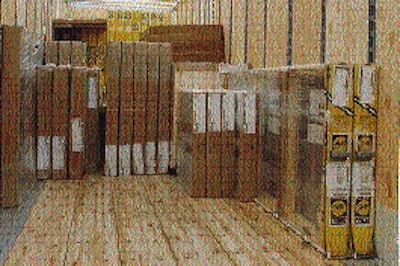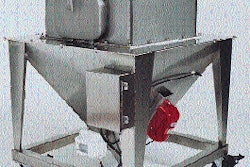Pella Corp. is widely recognized as the country's second-largest producer of prime windows. What's not so well known is that the firm is exercising a leadership position in packaging and shipping innovation. The Pella, IA-based company is now completing a major packaging change for its windows that has taken several years to implement in all window styles and in all plants. Today, the company is using a minimum of paperboard and stretch film that not only protects the costly windows, but allows truckers and other distribution employees to see exactly what they're handling. This has led to a noticeable damage reduction, though the company declines to quantify. Pella first applies corrugated die-cut telescoping corners that protect the window jambs. With these protective corners in place, the individual window is stretch wrapped in 80-ga Mobilrap(TM) S film from Mobil Chemical (Pittsford, NY). Each wrapped window is then loaded into trailers vertically, on end, much like books in a bookshelf. This technique not only reduces the amount of packaging used, it also has reduced handling damage and cut costs. Individual wrapping Six years ago, the company moved from stretch wrapping of pallet loads into wrapping of individual windows. Earlier, shrink wrap had been considered, "but it wasn't pursued very long," says Jeff Wetter, packaging project engineer. "Shortly before I joined the company in 1985, Pella began investigating alternatives to corrugated sleeves and the metal strapping it had always used for shipping the finished product," Wetter explains. "At the time, we were loading nine clad windows onto a pallet, and our aim was to get two pallets side by side in a trailer." At first, the company began to test use of a plastic bag placed around the pallet load and then shrunk tightly in a heat tunnel. But this technique was not only costly, it was also labor-intensive, too. To permit shipping two pallet loads side-by-side in trailers, Pella engineers first introduced the use of stretch film to bundle loads. Going a step farther, stretch wrapping individual windows was considered a new application six years ago. At that time, Pella's headquarters plant used platform type wrappers with a top platen holddown. To this pallet load wrapper, the company added a bracket that would permit those spiral stretch wrappers to wrap individual windows. This was the start of a three-month test of individual stretch wrapping. At the outset, Pella tried to use the same film that it had used in wrapping pallet loads. The company experienced some "blocking" problems. "We were stacking the individual windows flat on pallets with wood blocks between individual orders," Wetter recalls. The loads could be easily moved by forklift. But when a distributor wanted to take the individual window packs from the load, the film would stick together. Eventually, Mobil suggested its Mobilrap S, a three-layer cast film with one-side cling, one-side slip properties. With this film, the windows now slide into the trailer with ease, allowing the company to eliminate the need for a pallet. 'Psychological' handling In the '80s, Pella had worked hard to provide as much physical packaging protection as possible. Corrugated sleeves with end caps were used. Packages were clearly marked as windows, yet handling damage continued to be a problem. "Workers knew what was in the package, but they didn't give the product the kind of care it needed," says Wetter. "Once they could see the glass in the window through the stretch-wrap film, our windows were simply handled better. Damage was reduced significantly, but I don't have numbers to share. "You'd assume there was less protection because we replace corrugated with film. But suddenly, workers could see through packages and that reduced shipping errors-no wrong color, no wrong handling. Now you can look in the package and see what you have." Unlike other companies, Pella ships on its own trucks to distributors, so it doesn't face the uncertainties of common carrier handling. Casement windows produced at the headquarters plant were the style used in the trials. It's since been expanded to other windows produced at Pella, IA, and to another plant at Carroll, IA, where they make Pro-Line windows for builders. Those customers like the new package style for another reason. Job-site waste has become more important to contractors and builders. "We get a lot of feedback from distributors in the field about how much it costs to haul away dumpsters of packaging." says Wetter. Once again, no numbers are available on the reduction in packaging waste. Improved wrapping A couple of years ago, Pella began a program to convert several of its high-volume production lines to the use of Lan-ringer Model 200 wrappers from Lantech (Louisville, KY). These are spiral wrappers where the film moves vertically around a slow-moving window flat on a conveyor belt. Pella has four now, but it still uses several modified platform pallet wrappers that also do the job well. But not at Lan-ringer speed. "Because the wrapping is automatic and almost continuous, we use them only for items produced in volume," Wetter says. "Products we make in smaller volumes can still use platform wrappers without it being a bottleneck." At the headquarters plant, windows are fed to automatic wrappers from some 20 different production lines. Now, double-hung and fixed windows have joined the casement windows using the new wrapping technique. Even Pella's factory-assembled doors have adopted the new packaging style. Spread across Pella's different products, Wetter also likes the savings accrued in specific packaging parts. "At one time, we used something like 110 different corrugated packaging parts. Now we're down to about 14 with all the attendant savings in costs, space, inventory handling, etc.," Wetter says. "This was a dramatic change for us. This reduction in parts is one of the major benefits we enjoy." There was some apprehension on the part of distributors when the new package was brought out. "Most damage is to the cladding," Wetter says, "and we still cover the cladding with corrugated. So the product isn't that much different from when we used boxes or sleeves. We never had much glass breakage. "Actually the people who were most skeptical about the package change were our own shipping people," admits Wetter. "But once they and our distributors began to receive undamaged product, the acceptance grew." Wetter, incidentally, is a graduate of Michigan State University's School of Packaging, and this is "the most successful project that I've worked on in my career."






























